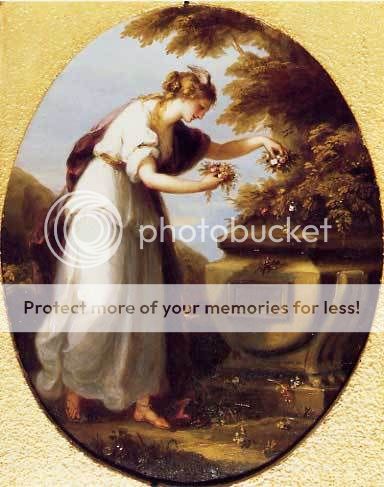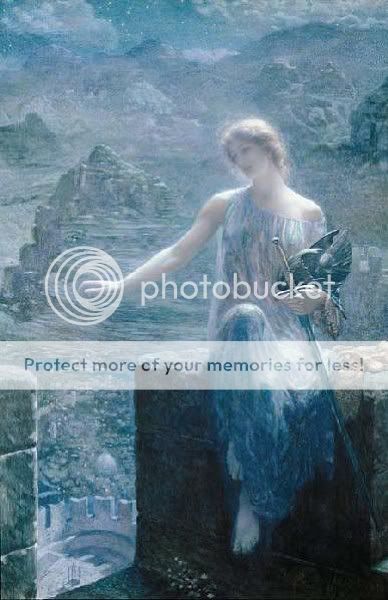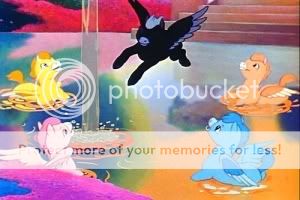Scene from The Taming of the Shrew - Washington Allston

In Act IV, Scene iii, Petruchio throws a tantrum when he sees the gown designed by the tailor for his wife Kate, who still needs further "taming." Petruchio says,
Antony and Cleopatra - Sir Lawrence Alma-Tadema

Cleopatra is awaiting the arrival of Antony, whose triremes is seen off in the distance.
In Act II, Scene ii, Enobarbus describes Cleopatra's boat to Agrippa and Mecaenas.

In Act IV, Scene iii, Petruchio throws a tantrum when he sees the gown designed by the tailor for his wife Kate, who still needs further "taming." Petruchio says,
Thy gown? why, ay: come, tailor, let us see't.
O mercy, God! what masquing stuff is here?
What's this? a sleeve? 'tis like a demi-cannon:
What, up and down, carved like an apple-tart?
Here's snip and nip and cut and slish and slash,
Like to a censer in a barber's shop:
Why, what, i' devil's name, tailor, call'st thou this? . . .
Thou yard, three-quarters, half-yard, quarter, nail!
Thou flea, thou nit, thou winter-cricket thou!
Braved in mine own house with a skein of thread?
Away, thou rag, thou quantity, thou remnant;
Or I shall so be-mete thee with thy yardv As thou shalt think on prating whilst thou livest!
I tell thee, I, that thou hast marr'd her gown.
Kate turns her face from the scene as she comes to the realization that there is little she can do or say at this point and that she will have no new gown for her sister's wedding.O mercy, God! what masquing stuff is here?
What's this? a sleeve? 'tis like a demi-cannon:
What, up and down, carved like an apple-tart?
Here's snip and nip and cut and slish and slash,
Like to a censer in a barber's shop:
Why, what, i' devil's name, tailor, call'st thou this? . . .
Thou yard, three-quarters, half-yard, quarter, nail!
Thou flea, thou nit, thou winter-cricket thou!
Braved in mine own house with a skein of thread?
Away, thou rag, thou quantity, thou remnant;
Or I shall so be-mete thee with thy yardv As thou shalt think on prating whilst thou livest!
I tell thee, I, that thou hast marr'd her gown.
Antony and Cleopatra - Sir Lawrence Alma-Tadema

Cleopatra is awaiting the arrival of Antony, whose triremes is seen off in the distance.
In Act II, Scene ii, Enobarbus describes Cleopatra's boat to Agrippa and Mecaenas.
The barge she sat in, like a burnish'd throne,
Burn'd on the water: the poop was beaten gold;
Purple the sails, and so perfumed that
The winds were love-sick with them; the oars were silver,
Which to the tune of flutes kept stroke, and made
The water which they beat to follow faster,
As amorous of their strokes. For her own person,
It beggar'd all description: she did lie
In her pavilion--cloth-of-gold of tissue--
O'er-picturing that Venus where we see
The fancy outwork nature: on each side her
Stood pretty dimpled boys, like smiling Cupids,
With divers-colour'd fans, whose wind did seem
To glow the delicate cheeks which they did cool,
And what they undid did. . . .
Her gentlewomen, like the Nereides,
So many mermaids, tended her i' the eyes,
And made their bends adornings: at the helm
A seeming mermaid steers: the silken tackle
Swell with the touches of those flower-soft hands,
That yarely frame the office. From the barge
A strange invisible perfume hits the sense
Of the adjacent wharfs. The city cast
Her people out upon her; and Antony,
Enthroned i' the market-place, did sit alone,
Whistling to the air; which, but for vacancy,
Had gone to gaze on Cleopatra too,
And made a gap in nature.
Agrippa's reply is simply, "Rare Egyptian!"Burn'd on the water: the poop was beaten gold;
Purple the sails, and so perfumed that
The winds were love-sick with them; the oars were silver,
Which to the tune of flutes kept stroke, and made
The water which they beat to follow faster,
As amorous of their strokes. For her own person,
It beggar'd all description: she did lie
In her pavilion--cloth-of-gold of tissue--
O'er-picturing that Venus where we see
The fancy outwork nature: on each side her
Stood pretty dimpled boys, like smiling Cupids,
With divers-colour'd fans, whose wind did seem
To glow the delicate cheeks which they did cool,
And what they undid did. . . .
Her gentlewomen, like the Nereides,
So many mermaids, tended her i' the eyes,
And made their bends adornings: at the helm
A seeming mermaid steers: the silken tackle
Swell with the touches of those flower-soft hands,
That yarely frame the office. From the barge
A strange invisible perfume hits the sense
Of the adjacent wharfs. The city cast
Her people out upon her; and Antony,
Enthroned i' the market-place, did sit alone,
Whistling to the air; which, but for vacancy,
Had gone to gaze on Cleopatra too,
And made a gap in nature.


































































